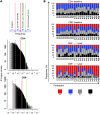T cell repertoire following autologous stem cell transplantation for multiple sclerosis
- PMID: 24531550
- PMCID: PMC3934160
- DOI: 10.1172/JCI71691
T cell repertoire following autologous stem cell transplantation for multiple sclerosis
Abstract
Autologous hematopoietic stem cell transplantation (HSCT) is commonly employed for hematologic and non-hematologic malignancies. In clinical trials, HSCT has been evaluated for severe autoimmunity as a method to "reset" the immune system and produce a new, non-autoimmune repertoire. While the feasibility of eliminating the vast majority of mature T cells is well established, accurate and quantitative determination of the relationship of regenerated T cells to the baseline repertoire has been difficult to assess. Here, in a phase II study of HSCT for poor-prognosis multiple sclerosis, we used high-throughput deep TCRβ chain sequencing to assess millions of individual TCRs per patient sample. We found that HSCT has distinctive effects on CD4+ and CD8+ T cell repertoires. In CD4+ T cells, dominant TCR clones present before treatment were undetectable following reconstitution, and patients largely developed a new repertoire. In contrast, dominant CD8+ clones were not effectively removed, and the reconstituted CD8+ T cell repertoire was created by clonal expansion of cells present before treatment. Importantly, patients who failed to respond to treatment had less diversity in their T cell repertoire early during the reconstitution process. These results demonstrate that TCR characterization during immunomodulatory treatment is both feasible and informative, and may enable monitoring of pathogenic or protective T cell clones following HSCT and cellular therapies.
Trial registration: ClinicalTrials.gov NCT00288626.
Figures



References
Publication types
MeSH terms
Substances
Associated data
LinkOut - more resources
Full Text Sources
Other Literature Sources
Medical
Research Materials

